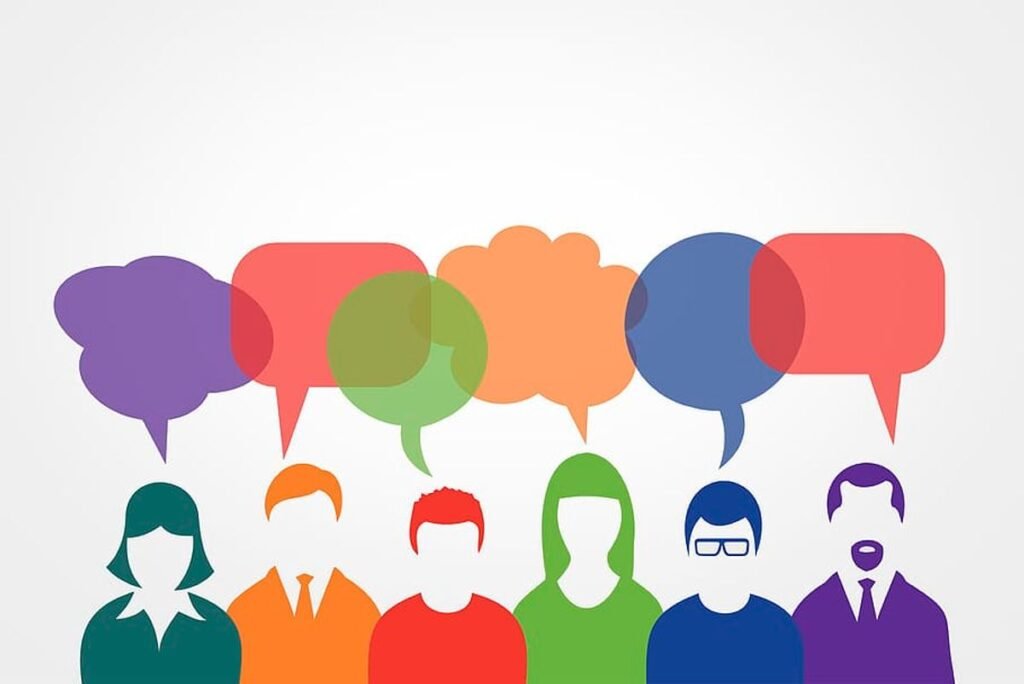Effective communication is a vital skill in both personal and professional relationships. Mastering the art of communication involves more than just speaking; it requires active listening, empathy, and the ability to navigate difficult conversations. In this guide, we will explore key strategies to enhance your dialogue and build stronger connections with others.
Key Takeaways
- Active listening is essential for effective communication.
- Building trust through transparency and respect is crucial.
- Managing emotions and finding common ground are important in difficult conversations.
- Nonverbal communication plays a significant role in understanding others.
- Establishing rapport and respecting boundaries contribute to successful communication.
The Power of Active Listening

Engaging with Empathy
Empathy is the cornerstone of meaningful communication. It involves not just hearing the words another person says, but also understanding and sharing their feelings. Active listening with empathy requires a conscious effort to be fully present in the conversation.
- Put aside your own thoughts and judgments.
- Focus on the speaker’s emotions and perspective.
- Respond with phrases that show understanding and validation.
By engaging with empathy, you create a safe space for open dialogue. This approach fosters a deeper connection and encourages others to express themselves more freely. Remember, empathy is not about agreeing with the other person, but about acknowledging their experience as valid.
When you listen with empathy, you give the speaker the invaluable gift of being seen and heard. This not only enhances the quality of the interaction but also paves the way for a more collaborative and trusting relationship.
Reflecting and Clarifying
Effective communication is not just about the words we say but also about how we echo the thoughts and feelings of others. Reflecting is a technique where you paraphrase or summarize what the other person has said, showing that you understand their message. This can be particularly powerful in demonstrating empathy and ensuring that both parties are on the same page.
Clarifying is equally important. It involves asking questions to make sure that you have fully grasped the meaning of what’s been communicated. This step is crucial to avoid misunderstandings and to dig deeper into the conversation.
By reflecting and clarifying, we not only show that we are actively engaged in the dialogue but also that we value the other person’s perspective.
Here are a few steps to effectively reflect and clarify in a conversation:
- Listen carefully to the speaker without interrupting.
- Repeat back what you’ve heard in your own words.
- Ask open-ended questions to encourage elaboration.
- Summarize the main points to confirm understanding.
- Offer feedback or share your own perspective once clarity is achieved.
Nonverbal Communication
Mastering nonverbal communication is a cornerstone of effective dialogue. It’s not just about what we say, but how we say it. Body language, facial expressions, and tone of voice all play pivotal roles in conveying our true intentions and feelings.
- Maintain eye contact to show engagement
- Use gestures to emphasize points
- Be mindful of your posture as it reflects confidence
Subtleties in nonverbal cues can significantly impact the message received by the other person. It’s crucial to be aware of these nuances to avoid misunderstandings.
Nonverbal signals can bridge the gap between words and meaning, providing clarity where words alone may fall short.
Remember, effective nonverbal communication complements verbal interactions, creating a harmonious and comprehensive exchange. Paying attention to these silent signals can enhance your ability to connect with others on a deeper level.
Building Trust through Communication
 Building Trust through Communication” >
Building Trust through Communication” >
Being Transparent and Honest
In the realm of effective communication, transparency is the cornerstone of building trust. When we are transparent, we lay a foundation for sincerity that resonates with others. This means sharing our true thoughts and feelings, and being open about our intentions and limitations.
Honesty is not just about telling the truth, but also about being genuine and authentic. It requires courage and integrity, as it sometimes means having to share uncomfortable truths. However, the benefits of being honest far outweigh the temporary discomfort it may cause:
- It fosters a culture of openness and safety.
- It encourages mutual respect and understanding.
- It prevents misunderstandings and builds stronger relationships.
Being transparent and honest is not just a moral choice, but a practical strategy for deepening connections and ensuring that our words are taken seriously.
Respecting Boundaries
In the realm of effective communication, respecting boundaries is paramount. It’s about recognizing and honoring the limits that each person sets in a conversation. This can range from topics they are uncomfortable discussing to the amount of personal space they require.
Boundaries are not just about what is said, but also about what is left unsaid. It’s crucial to pay attention to cues that indicate when someone is reaching their limit. Here are a few steps to ensure you respect others’ boundaries:
- Ask for permission before delving into sensitive topics.
- Be mindful of the other person’s body language and verbal feedback.
- Acknowledge when a boundary has been stated and adjust the conversation accordingly.
Respecting boundaries is not a sign of weakness but a mark of mutual respect and understanding in any dialogue.
By adhering to these principles, you foster a safe environment for open and honest communication. It’s about creating a space where everyone feels heard and valued, without the fear of overstepping personal comfort zones.
Establishing Rapport
Establishing rapport is a cornerstone of effective communication. It’s about creating a connection that goes beyond the exchange of information. Rapport builds a foundation for trust, allowing conversations to flow more naturally and openly.
- Start with common interests or experiences
- Use open body language
- Mirror the other person’s tone and pace
Empathy plays a significant role in this process. By showing genuine interest in the other person’s thoughts and feelings, you create a comfortable environment for dialogue. Remember, rapport isn’t just about being friendly; it’s about fostering a sense of mutual understanding and respect.
The goal is to establish a connection that encourages ongoing communication. It’s not just about the current conversation, but about building a bridge for future interactions.
Navigating Difficult Conversations

Managing Emotions
In the realm of difficult conversations, the ability to manage one’s emotions is paramount. Keeping a level head allows for clearer thinking and prevents the escalation of tension. Here are a few steps to help maintain emotional control:
- Recognize your feelings without judgment.
- Take deep breaths to center yourself.
- Pause before responding to collect your thoughts.
It’s essential to acknowledge that emotions are natural and can be informative. They reflect our values and perceptions, and thus, understanding them can lead to more productive dialogue.
By managing emotions effectively, we create space for empathy and understanding. This doesn’t mean suppressing feelings but rather expressing them in a way that is conducive to resolution and mutual respect.
Finding Common Ground
In the midst of a difficult conversation, finding common ground can be the bridge that connects disparate perspectives. It’s about identifying shared values, experiences, or goals that can form the basis for mutual understanding. To achieve this, one must:
- Listen actively to the other person’s viewpoint.
- Acknowledge the areas of agreement, no matter how small.
- Explore interests behind the positions held by each party.
By focusing on what unites rather than what divides, parties can move towards a more collaborative and less adversarial dialogue.
Finding common ground does not mean compromising your values or agreeing for the sake of peace. It’s about creating a foundation for more effective and empathetic communication. When both parties feel understood and acknowledged, the path to resolving conflicts becomes clearer.
Resolving Conflicts
Conflict resolution is an essential skill in any form of dialogue. Finding a mutually acceptable solution often requires patience, understanding, and creativity. It’s important to approach conflicts with a problem-solving mindset, focusing on the issue rather than the individuals involved.
Compromise is key in resolving disputes. Here are some steps to consider when working towards a resolution:
- Clearly define the problem from both perspectives.
- Identify the needs and concerns of each party.
- Explore possible solutions together.
- Agree on a fair and practical solution.
- Establish a plan for implementing the agreed-upon solution.
Remember, the goal is not to win the argument, but to reach an understanding that respects everyone’s interests. Effective conflict resolution can strengthen relationships and foster a culture of cooperation and respect.
Difficult conversations are a part of life, but they don’t have to be daunting. At CoffeeWithView.com, we provide insights and strategies to help you navigate these challenging interactions with confidence. Whether it’s in your personal life or professional sphere, our expert advice can make a significant difference. Ready to transform the way you communicate? Visit our website for valuable tips and join our community of effective communicators today!
Conclusion
In conclusion, mastering the art of communication is essential for building strong relationships, resolving conflicts, and achieving success in both personal and professional settings. By following the principles and strategies outlined in this guide, you can improve your dialogue skills and become a more effective communicator. Remember, communication is a two-way street that requires active listening, empathy, and clarity. Practice these techniques consistently, and you will see positive results in your interactions with others. Start implementing these tips today and watch your communication skills soar!
Frequently Asked Questions
How can active listening improve communication?
Active listening involves fully engaging with the speaker, showing empathy, and reflecting on what they say. This helps build trust and understanding in conversations.
Why is nonverbal communication important in dialogue?
Nonverbal cues such as body language and facial expressions play a significant role in conveying emotions and intentions, enhancing the overall communication experience.
How does transparency contribute to building trust?
Being transparent and honest in communication fosters openness and credibility, which are essential for establishing trust and strengthening relationships.
What strategies can help in managing emotions during difficult conversations?
Techniques like deep breathing, taking a break, and using ‘I’ statements can help regulate emotions and promote a constructive dialogue even in challenging situations.
How can finding common ground facilitate effective communication?
Identifying shared interests or goals with the other party can create a foundation for understanding and collaboration, leading to more productive conversations.
What are some tips for resolving conflicts peacefully?
Active listening, staying calm, and seeking mutually beneficial solutions through compromise and negotiation can help in resolving conflicts in a respectful and constructive manner.



